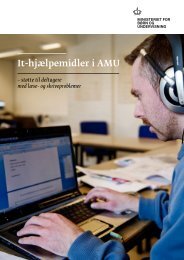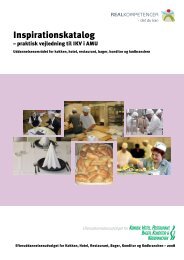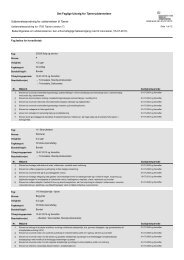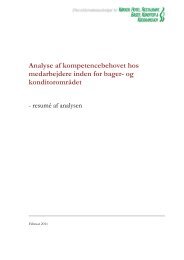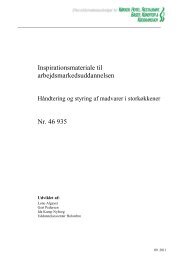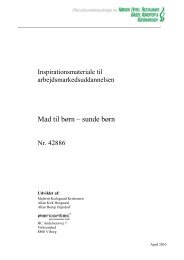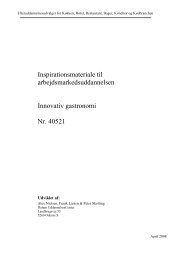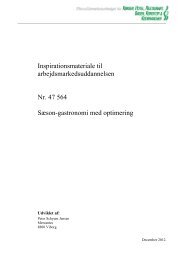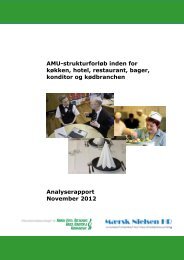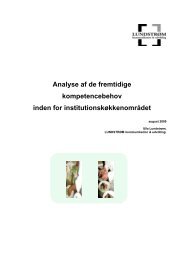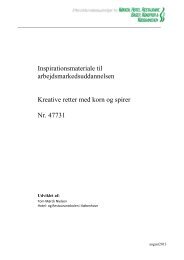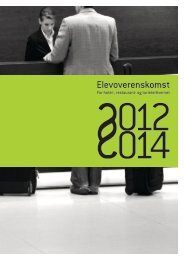General food hygiene - the certificate training
General food hygiene - the certificate training
General food hygiene - the certificate training
You also want an ePaper? Increase the reach of your titles
YUMPU automatically turns print PDFs into web optimized ePapers that Google loves.
*1 Own-check<br />
***i ramme<br />
Own-check is <strong>the</strong> systematic actions that <strong>the</strong> businesses conduct to make sure that <strong>the</strong> legislation on<br />
<strong>food</strong>stuff is complied with. That is, own-check is routines that <strong>the</strong> staff carry out during all<br />
productions.<br />
***ramme slut<br />
The own-check must ensure that <strong>the</strong> <strong>food</strong> that is served or sold does not constitute a risk for <strong>the</strong><br />
health of humans.<br />
To work with own-check means to focus on <strong>the</strong> critical points in <strong>the</strong> kitchen. When <strong>the</strong> critical<br />
points have been identified, and kitchen routines and working procedures have been put into<br />
system, you will have a nice tool to secure an efficient own-check.<br />
***i ramme<br />
Critical points<br />
A critical point is a place:<br />
• Where danger exists for <strong>the</strong> propagation of microorganisms that is already present in <strong>the</strong><br />
<strong>food</strong>.<br />
• Where danger exists for adding new microorganisms to <strong>the</strong> <strong>food</strong>.<br />
• Where physical or chemical contamination of <strong>the</strong> <strong>food</strong> can happen.<br />
***ramme slut<br />
***ramme<br />
A critical control point is a critical point you are able to control.<br />
***ramme slut<br />
***fotos<br />
A part of working with <strong>the</strong> own-check program is to register <strong>the</strong> critical points (risk analysis).<br />
*2 Risk analysis and critical control points<br />
A risk analysis consists of:<br />
a) Assessing which risks are associated with <strong>the</strong> current handling and selling/serving of<br />
<strong>food</strong>stuff and how serious and frequent <strong>the</strong>se risks are. To point out where <strong>the</strong>se risk can<br />
occur.<br />
b) Deciding which of <strong>the</strong> identified risks can be controlled in <strong>the</strong> production procedure and<br />
thus is a critical control point.<br />
c) Establishing limits for what is acceptable (critical limit), so that it is clear in advance when<br />
deviations or irregularities occur.<br />
d) Establishing and completing surveillance procedures to make sure that <strong>the</strong> <strong>food</strong>stuff is<br />
treated correctly at <strong>the</strong> critical control points. Effective surveillance procedures must exist<br />
for all critical control points, including <strong>the</strong> frequency of <strong>the</strong> procedure and who is<br />
responsible.<br />
e) Specifying what must happen with <strong>the</strong> product in question, if errors are disclosed and<br />
perform a corrective action, so that <strong>the</strong> error is not repeated.<br />
f) Establishing when, how and how often <strong>the</strong> own-check must be revised, that is establishing a<br />
procedure that ensures that <strong>the</strong> procedures described from a to e works properly. The owncheck<br />
must also be adjusted to changes in <strong>the</strong> activity of <strong>the</strong> business.<br />
g) Drawing up documents and keeping records to document that <strong>the</strong> procedures works<br />
efficiently.<br />
***foto<br />
The result must be recorded to prove that <strong>the</strong> work has been performed correctly.<br />
***i ramme<br />
29



